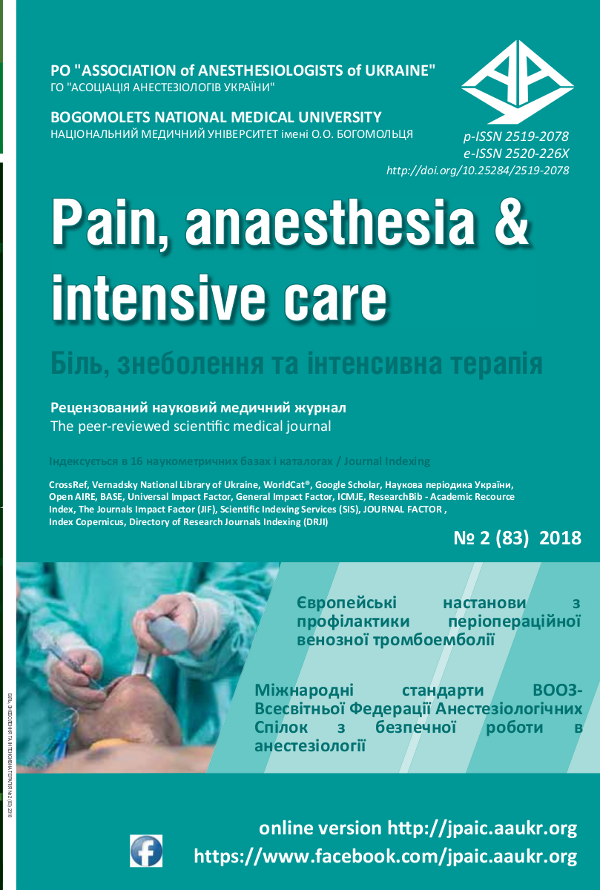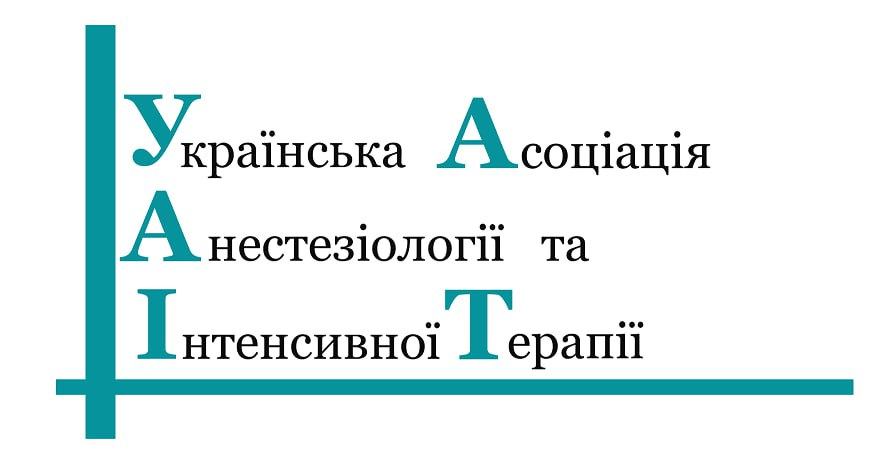Надання невідкладної медичної допомоги пацієнтам, які отримують пероральні антикоагулянти, що не є антагоністами вітаміну К
DOI:
https://doi.org/10.1016/j.bja.2017.11.082Ключові слова:
антикоагулянти, моніторинг коагуляції, надзвичайні ситуації, крововилив, скасування ефектуАнотація
© 2017 Автор(и). Опубліковано видавництвом «Elsevier Ltd» від імені Британського журналу анестезії. Ця стаття знаходиться у відкритому доступі та розповсюджується за ліцензією CC BY-NC-ND (http://creativecommons.org/licenses/by-nc-nd/4.0/). Для отримання дозволу звертайтесь за електронною адресою: permissions@elsevier.com Пероральні антикоагулянти, що не є антагоністами вітаміну K (NOAC), які інгібують тромбін (дабігатран) та фактор Xa (рівароксабан, апіксабан, едоксабан) були впроваджені для використання за декількома клінічними показаннями. Хоча NOAC мають сприятливе співвідношення користь-ризик і можуть використовуватися без рутинного лабораторного моніторингу, як і інші антикоагулянти, вони асоціюються з ризиком кровотечі. Крім того, пацієнтам які потребують хірургічної операції або інших процедур, може знадобитись переривання лікування. Метою цієї статті, підготовленої міждисциплінарною групою фахівців з тромбозу та гемостазу, є оновлення стратегії лікування пацієнтів, які отримують NOAC, котрі зазнають кровотечі або потребують термінового втручання. Очікується, що останні досягнення в розробці таргетних препаратів зворотної дії допоможуть оптимізувати ведіння пацієнтів, які отримують NOAC, котрі потребують швидкого скасування антикоагулянтного ефектуПосилання
Barnes GD, Ageno W, Ansell J, Kaatz S. Recommendation on the nomenclature for oral anticoagulants: communication from the SSC of the ISTH. J Thromb Haemost 2015; 13: 1154–6
 |
|  |
| 
Yeh CH, Hogg K, Weitz JI. Over view of the new oral anticoagulants: opportunities and challenges. Arterioscler Thromb Vasc Biol 2015; 35: 1056–65
 |
|  |
| 
Heidbuchel H, Verhamme P, Alings M, et al. Updated European Heart Rhythm Association Practical Guide on the use of non-vitamin K antagonist anticoagulants in patients with non-valvular atrial fibrillation. Europace 2015; 17:1467–507
 |
|  |
| 
Siegal DM, Cuker A. Reversal of novel oral anticoagulants in patients with major bleeding. J Thromb Thrombolysis 2013; 35:391–8
 |
|  |
| 
van Ryn J, Stangier J, Haertter S, et al. Dabigatran etexilateea novel, reversible, oral direct thrombin inhibitor: interpretation of coagulation assay sand reversal ofanticoagulant activity. Thromb Haemost 2010; 103: 1116–27
 |
|  |
| 
Hawes EM, Deal AM, Funk-Adcock D, et al. Performance of coagulation tests in patients on therapeutic doses of dabigatran: a cross-sectional pharmacodynamic study based on peak and trough plasma levels. J Thrmb Haemost 2013; 11: 1493–502
 |
|  |
| 
Cuker A, Siegal DM, Crowther MA, Garcia DA. Laboratory measurement of the anticoagulant activity of the nonvitamin K oral anticoagulant s. J Am Coll Cardiol 2014; 64: 1128–39
 |
|  |
| 
Dias JD, Norem K, Doorneweerd DD, Thurer RL, Popovsky M A , Omert L A. Use of thromboelastography (TEG) for detection of new oral anticoagulants. Arch Pathol Lab Med 2015; 139: 665–73
 |
|  |
| 
Solbeck S, Meyer MA, Johansson PI, et al. Monitoring of dabigatran anticoagulation and its reversal in vitro by thrombe lastography. Int J Cardiol 2014; 176: 794–9
 |
|  |
| 
Solbeck S, Ostrowski SR, Stensballe J, Johansson P I. Thrombe lastography detects dabigatran at the rapeutic concentrations in vitro to the sameextentas gold-standard tests. Int J Cardiol 2016; 208: 14–8
 |
|  |
| 
Grottke O, van Ryn J, Spronk HM, Rossaint R. Prothromb in complex concentrates and aspecific antidote to dabigatran are effective ex-vivo in reversing the effects of dabigatran in an anticoagulation/liver traum a experimental model. Crit Care 2014; 18: R 27
 |
|  |
| 
Taune V, Wall? en H, AЪgren A, et al. Whole blood coagulation assays ROTEM and T-TAS to monitor dabigatran treatment. Thromb Res 2017; 153:76–82
 |
|  |
| 
Eller T, Busse J, Dittrich M, et al. Dabigatran, rivaroxaban, apixaban, argatroban and fondaparinux and the ireffects on coagulation POC and platelet function tests. Clin Chem Lab Med 2014; 52: 835–44
 |
|  |
| 
van Ryn J, Grottke O, Spronk H. Measurement of dabigatran in standardly used clinical assays, whole blood viscoelastic coagulation, and thrombin generation assays. Clin Lab Med 2014; 34: 479–501
 |
|  |
| 
Stangier J, Feuring M. Using the HEMOCLOT direct thrombin inhibitor assay to determineplasm a concentrations of dabigatran. Blood Coagul Fibrinolysis 2012; 23 : 138–43
 |
|  |
| 
Schmitz EM, Boonen K, van den Heuvel DJ, et al. Determination of dabigatran, rivarox aban and apix aban by ultra-performance liquid chromatographyetandem mass spectrometry (UPLC-MS/MS) and coagulation assays for therapy monitoring of novel directoral anticoagulants. J Thromb Haemost 2014; 12: 1636–46
 |
|  |
| 
Douxfils J, Mullier F, Robert S, Chatelain C, Chatelain B, Dogne JM. Impact of dabigatran on a large panel of routine or specific coagulation assays. Laboratory recommendations for monitoring of dabigatran etexilate. Thromb Haemost 2012; 107: 985–97
 |
|  |
| 
Dale B J, Ginsberg JS, Johnston M , Hirsh J, Weitz JI, Eikelboom JW. Comparison of the effects of a pixaban and rivaroxaban on prothrombinand activated partial thromboplastin times using variousre agents. J Thromb Haemost 2014; 12: 1810–5
 |
|  |
| 
Francart SJ, Hawes EM, Deal AM, et al. Performance of coagulation tests in patients on the rapeutic doses of rivaroxaban. A cross- sectional pharmacodynamic study based on peak and trough plasma levels. Thromb Haemost 2014; 111:1133–40
 |
|  |
| 
Morishima Y, Kam isato C. Laboratory measure ments of the oral direct factor Xainhibitor edoxaban: comparison of prothrombintime, activated partial thromboplastin time, and thrombin generation assay. Am J Clin Pathol 2015; 143:241–710-Eikelboometal.
 |
|  |
| 
Adelmann D, Wiegele M, Wohlgemuth RK, et al. Measuring the activity of apixaban and rivaroxaban with rotational thrombelastometry. Thromb Res 2014; 134: 918–23
 |
|  |
| 
Casutt M, Konrad C, Schuepfer G. Effect of rivaroxaban on blood coagulation using the viscoelastic coagulation test ROTEM. Anaesthesist 2012; 61: 948–53
 |
|  |
| 
Samama MM, Meddahi S, Samama CM. Pharmacology and laboratory testing of the oral Xa inhibitors. Clin Lab Med 2014; 34: 503–17
 |
|  |
| 
Eikelboom JW, Quinlan DJ, Hirsh J, Connolly SJ, Weitz JI . Laboratory monitoring of non-vitamin K antagonist oral anticoagulant use in patients with atrial fibrillation: a review. JAMA Cardiol 2017; 2: 566–74
 |
|  |
| 
Siegal DM, Cuker A. Reversal of target-specific oral anticoagulants. Drug Discov Today 2014; 19: 1465–70
 |
|  |
| 
Siegal DM, Garcia DA, Crowther M A. How I treat targets pecific oral anticoagulant-associated bleeding. Blood 2014; 123: 1152–8
 |
|  |
| 
Fries D, Giurea A, Gutl M, et al. Management of dabigatran-induced bleeding: expert statement. Wien Klin Wochenschr 2013; 125: 721–9
 |
|  |
| 
Kaatz S, Crowther M. Reversal of target-specific oral anticoagulants. J Thromb Thrombolysis 2013; 36: 195–202
 |
|  |
| 
Grottke O, Levy JH. Prothrombin complex concentrates in trauma and perioperative bleeding. Anesthesiology 2015; 122: 923–31
 |
| 
Samama CM. Prothrombin complex concentrates: a brief review. Eur J Anaesthesiol 2008; 25: 784–9
 |
| 
Rodgers GM. Prothrombin complex concentrates in emergency bleeding disorders. Am J Hematol 2012; 87: 898–902
 |
| 
Dentali F, Marchesi C, Pierfranceschi MG, et al. Safety of prothrombin complex concentrates for rapid anticoagulation reversal of vitamin Kantagonists. A metaanalysis. Thromb Haemost 2011; 106: 429–38 doi: 10.1160/TH11-01-0052
 |
| 
Dickneite G, Hoffman M. Reversing the new oral anticoagulants with prothrombin complex concentrates (PCCs): what is the evidence? Thromb Haemost 2014; 111: 189–98
 |
| 
Grottke O, Aisenberg J , Bernstein R, et al. Efficacy of prothrombin complex concentrates for the emergency reversal of dabigatran-induced anticoagulation. Crit Care 2016; 20:115
 |
| 
McGovern TR, Mc Namee JJ, Malabanan C, Fouad MA, Pate lN. Use of 4-factor prothrombin complex concentrate in the treatment of a gastrointestinal hemorrhage complicated by dabigatran. Int J Emerg Med 2015; 8:10

Masotti L, Lorenzini G, Seravalle C, et al. Management of new oral anticoagulants related life threatening or major bleedings in real life: a brief report. J Thromb Thrombolysis 2015; 39: 427–33
 |
| 
Durie R, Kohute M, Fernandez C, Knight M. Prothrombin complex concentrate for the management of severe traumatic bleeding in a patient anticoagulated with apixaban. J Clin Pharm Ther 2016; 41: 92–3
 |
| 
Grandhi R, Newman WC, Zhang X, et al. Administration of 4-factor prothrombin complex concentrate as an antidote for intracranial bleeding in patients taking direct factor Xainhibitors. World Neurosurg 2015; 84: 1956–61
 |
| 
Hoffman M, Dargaud Y. Mechanisms and monitoring of bypassing agent therapy. J Thromb Haemost 2012; 10: 1478–85
 |
| 
Ehrlich HJ, Henzl MJ, Gomperts ED. Safety of factor VIII inhibitor bypass activity (FEIBA): 10-year compilation of thrombotic adverse events. Haemophilia 2002; 8: 83–90
 |
| 
Dager WE, Gosselin RC, Roberts AJ. Reversing dabigatran in life-threatening bleeding occurring during cardiacablation with factor eight inhibitor by passing activity. Crit Care Med 2013; 41: 42–6
 |
| 
Schulman S, Ritchie B, Goy JK, Nahirniak S, Almutawa M , Ghanny S. Activated prothrombin complex concentrate for dabigatran-associated bleeding. Br J Haematol 20 14; 164: 308–10
 |
| 
Vanden Daelen S, Peetermans M, Vanassche T, Verhamme P, Vandermeulen E . Monitoring and reversal strate gies for new oral anticoagulants. Expert Rev Cardiovasc Ther 2015; 13:95–103
 |
| 
Ragni MV. The old and new: PCCs, VIIa, and long-lasting clotting factors for hemophilia and other bleeding disorders. Hematol Am Soc Hematol Educ Program 2013; 2013: 44–51
 |
| 
Neufeld EJ, Negrier C, Arkhammar P, et al. Safety update on the use of recombinant activated factor VII in approved indications. B lood R ev 2015; 29(Suppl 1): S34–41
 |
| 
Levi M, Levy JH, Andersen HF, Truloff D. Safety of recombinant activated factor VII in randomized clinical trials. N Engl J Med 2010; 363: 1791–800
 |
| 
Zhou W, Schwarting S, Illanes S, et al. Hemostatic the rapy inexperimental intracerebral hemorrhage associated with the direct thrombin inhibitor dabigatran. Stroke 2011; 42:3594–9
 |
| 
Lambourne MD, Eltringham-Smith LJ, Gataiance S, Arnold DM, Crowther MA, Sheffield WP. Prothrombin complex concentrates reduce blood loss in murine coagulopathy induced by warfarin, but not in that induced by dabigatran etexilate. J Thromb Haemost 2012; 10: 1830–40
 |
| 
Godier A, Miclot A, Le Bonniec B, et al. Evaluation of prothrombin complex concentrate and recombinant activated factor VII to reverse rivaroxaban in a rabbit model. Anesthesiology 2012; 116:94– 102
 |
| 
Martin AC, Le Bonniec B, Fischer AM, et al. Evaluation of recombinant activated factor VII, prothrombin complex concentrate, and fibrinogen concentrate to reverse apixaban in a rabbit model of bleeding and thrombosis. Int J Cardiol 2013; 168: 4228–33
 |
| 
Hoffman M, Volovyk Z, Monroe DM. Reversal of dabigatran effects in models of thrombin generation and hemostasis by factor VII a and prothrombin complex concentrate. Anesthesiology 2015; 122: 353–62
 |
| 
Henry DA, Carless PA, Moxey AJ, et al. Anti-fibrinolytic use for minimising perioperative allogeneic blood transfusion. Cochrane Database Syst Rev 2011, CD001886
 |
| 
Shakur H, Roberts I, Bautista R, et al. Effects of tranexamic acid on death, vascular occlusive events, and blood transfusion in trauma patients with significant haemorrhage (CRASH-2): a randomised, placebo-controlled trial. Lancet 2010; 376: 23–32
 |
| 
Rossaint R, Bouillon B, Cerny V, et al. The European guideline on management of major bleeding and coagulopathy following trauma: fourth edition. Crit Care 2016; 20: 100
 |
| 
Wang X, Mondal S, Wang J, et al. Effect of activated charcoal on apixaban pharmacokinetic sinhealthy subjects. Am J Cardiovasc Drugs 2014; 14: 147–54 Emergency care of NOAC- treated patients-11
 |
| 
Woo J S, Kapadia N, Phanco SE, Lynch CA. Positive outcome after intentional overdose of dabigatran. J Med Toxicol 2013; 9:192–5
 |
| 
Khadzhynov D, Wagner F, Formella S, et al. Effective elimination of dabigatran by haemodialysis. A phase I single-centre study in patients with end-stagerenal disease. Thromb Haemost 2013; 109:596–605
 |
| 
Chai-Adisaksopha C, Hillis C, Lim W, Boonyawat K, Moffat K, Crowther M. Hemodialysis for the treatment of dabigatran-associated bleeding: a case report and systematic review. J Thromb Haemost 2015; 13: 1790–8
 |
| 
Parasrampuria DA, Marbury T, Matsushima N, et al. Pharmacokinetics, safety, and tolerability of edoxabanin end-stage renal disease subjects undergoing haemodialysis. Thromb Haemost 2015; 113: 719–27
 |
| 
Costin J, Ansell J, Laulicht B, Bakhru S, Steiner S. Reversal agents in development for the new oral anticoagulants. Postgrad Med 2014; 126: 19–24
 |
| 
Schiele F, van Ryn J, Canada K, et al. A specific antidote for dabigatran: functional and structural characterization. Blood 2013; 121: 3554–62
 |
|  |
| 
Glund S, Moschetti V, Norris S, et al. A randomised study in healthy volunteers to investigate the safety, tolerability and pharmacokinetics of idarucizumab, a specificantidote to dabigatran. Thromb Haemost 2015; 113: 943–51
 |
|  |
| 
Schmohl M, Glund S, Harada A, et al. Idarucizumab does not have procoagulant effects: assessment of thrombosis biomarkers in healthy volunteers. Thromb Haemost 2017; 26:269–76
 |
|  |
| 
Glund S, Stangier J, Schmohl M, et al. Safety, tolerability, and efficacy of idarucizumab for the reversal of the anticoagulant effect of dabigatran in healthy male volunteers: a randomised, placebo-controlled, double-blind phase 1 trial. Lancet 2015; 386: 680–90
 |
|  |
| 
Glund S, Stangier J, van Ryn J, et al. Effect of age and renal function on idarucizumab pharmacokinetics and idarucizumab-mediated reversal of dabigatran anti-coagulant activity in a randomized, double-blind, crossover PhaseIb study. Clin Pharmacokinet 2017; 56: 41–54
 |
|  |
| 
Glund S, Stangier J, van Ryn J, et al. Restarting dabigatranet exilate 24 hafter reversal with idarucizumab and redosing idarucizumab in healthy volunteers. J Am Coll Cardiol 2016; 6 7: 1654–6
 |
|  |
| 
Pollack Jr CV, Reilly PA, van Ryn J, et al. Idarucizumab for dabigatran reversale full cohortanalysis. N Engl J Med 2017; 377: 431–41
 |
|  |
| 
Eikelboom JW, Quinlan DJ, van Ryn J, Weitz JI. Idarucizumab: the antidote for reversal of dabigatran. Circulation 2015; 132: 2412–22
 |
|  |
| 
Lu G, DeGuzman FR, Hollenbach SJ, et al. A specific antidote for reversal of anticoagulation by direct and indirect inhibitors of coagulation factor Xa. Nat Med 2013; 19:446–51
 |
|  |
| 
Siegal DM , Curnutte JT, Connolly SJ, e t al. Andexanet alfa for the reversal of factor Xa inhibitor activity. N Engl J Med 2015; 373 : 2413–24
Connolly SJ, Milling JrTJ, Eikelboom J W, et al. Andexanet alfa for acute major bleeding associated with factor Xa inhibitors. N Engl J Med 2016; 375: 1131e41
Ansell JE, Bakhru SH, Laulicht BE, et al. Use of PER977 to reverse the anticoagulant effect of edoxaban. N Engl J Med 2014; 371: 2141–2
Alikhan R, Rayment R, Keeling D, et al. The acute man agement of haemorrhage, surgery and over dose in patients receiving dabigatran. Emerg Med J 2014; 31: 163–8
 |
|  |
| 
Kyrle PA, Binder K, Eichinger S, et al. Dabigatran: patient management in specific clinical settings. Wien Klin Wochenschr 2014; 126: 503–8
 |
|  |
| 
Pernod G , Albaladejo P, Godier A, et al. Management of major bleeding complications and emergency surgery in patients on long-term treatment with directoral anticoagulants, thrombinor factor-Xa inhibitors: proposals of the working group on perioperative haemostasis (GIHP) –March 2013. Arch Cardiovasc Dis 2013; 106: 382–93
 |
|  |
| 
Tran H, Joseph J, Young L, et al. New oral anticoagulants: a practical guide on prescription, laboratory testing and peri-procedural/bleeding management. Intern Med J 2014; 44:525–36
 |
|  |
| 
Sherwood MW, Douketis JD , Patel MR , et al. Outcomes of temporary interruption of rivaroxaban compared with warfarin in patients with nonvalvular atrial fibrillation: results from the rivaroxaban once daily, oral, direct factor Xa in hibition compared with vitamin K antagonism for prevention of stroke and embolism trial in atrial fibrillation (ROCKET AF). Circulation 2014; 129: 1850–9
 |
|  |
| 
Douketis JD, Healey JS, Brueckmann M, et al. Urgent surgery or procedures in patients taking dabigatran or warfarin: analysis of perioperative out comes from the RELY trial. Thromb Res 2016; 139: 77–81
 |
|  |
| 
Beyer-Westendorf J, Gelbricht V, F€ orster K, et al. Periinterventional management of novel oral anticoagulants in daily care: results from the prospective Dresden NOAC registry. Eur Heart J 2014; 35: 1888–96
 |
|  |
| 
Gogarten W, Vandermeulen E, Van Aken H, Kozek S, Llau JV, Samama CM. Regional anaesthesia and antithrombotic agents: recommendations of the European Society of Anaesthesiology. Eur J Anaesthesiol 2010; 27: 999–1015
 |
|  |
| 
Kozek-Langenecker SA, Ahmed AB, Afshari A, et al. Management of severe perioperative bleeding: guidelines from the European Society of Anaesthesiology: first update 2016. Eur J Anaesthesiol 2017; 34: 332–95 Handling editor: J.G. Hardman doi: 10.1097/EJA.0000000000000630
 |
| 
##submission.downloads##
Опубліковано
Як цитувати
Номер
Розділ
Ліцензія
Авторське право (c) 2018 J. W. Eikelboom, S. Kozek-Langenecker, A. Exadaktylos, A. Batorova, Z. Boda, F. Christory, I. Gornik, G. Kekstas

Ця робота ліцензується відповідно до Creative Commons Attribution-NonCommercial 4.0 International License.
Автори, які публікуються у цьому журналі, погоджуються з наступними умовами:
a. Автори залишають за собою право на авторство своєї роботи та передають журналу право першої публікації цієї роботи на умовах ліцензії Creative Commons Attribution-NonCommercial 4.0 International License, котра дозволяє іншим особам вільно розповсюджувати опубліковану роботу з обов'язковим посиланням на авторів оригінальної роботи та першу публікацію роботи у цьому журналі.
b. Автори мають право укладати самостійні додаткові угоди щодо неексклюзивного розповсюдження роботи у тому вигляді, в якому вона була опублікована цим журналом (наприклад, розміщувати роботу в електронному сховищі установи або публікувати у складі монографії), за умови збереження посилання на першу публікацію роботи у цьому журналі.
c. Політика журналу дозволяє і заохочує розміщення авторами в мережі Інтернет (наприклад, у сховищах установ або на особистих веб-сайтах) рукопису роботи, як до подання цього рукопису до редакції, так і під час його редакційного опрацювання, оскільки це сприяє виникненню продуктивної наукової дискусії та позитивно позначається на оперативності та динаміці цитування опублікованої роботи (див. The Effect of Open Access).








